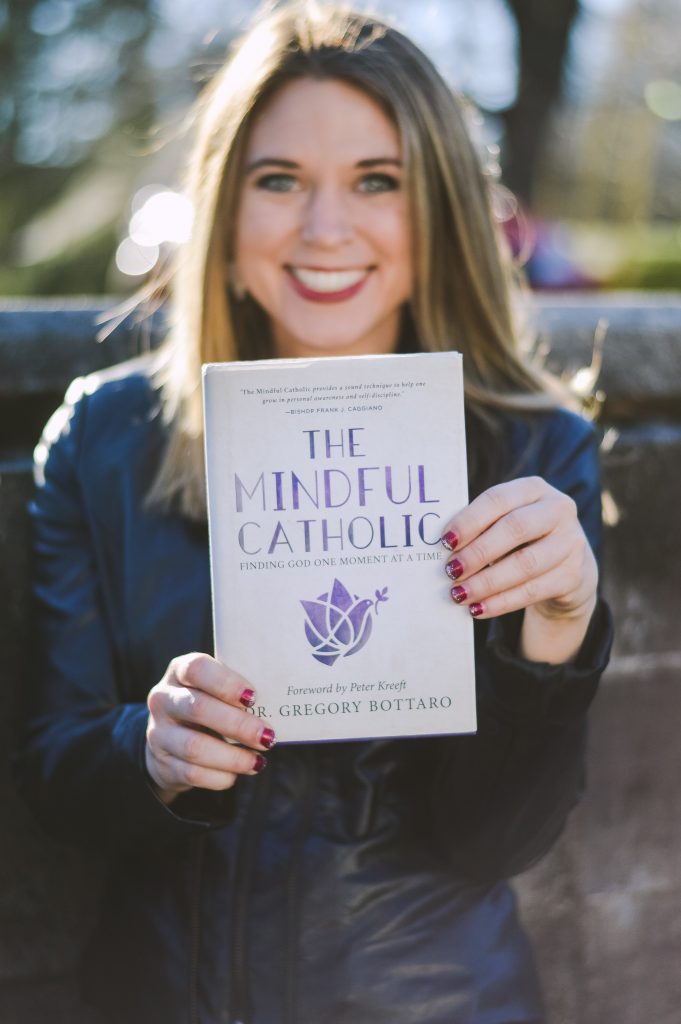
Oh, my dear friends, I cannot even express to you how excited I am to finally share this blog post with you. First, because I’m finished the program (woo!). Second, because it has shown me a new side to life that I never took the time to experience. Third, because it brought me so much peace and joy knowing that we’re talking about mental health in the Church.
If you haven’t been following along on social media, let me fill you in. Back in September, I started a program through the CatholicPsych Academy called Introduction to Catholic Mindfulness.
You can check out the program AND receive $50 off by heading to this link and using the code runningmyselftogether.
When I first started this mindfulness program, I thought I could get through it easy, breezy – sharing something once a week and walking away feeling a bit better and with a lot more knowledge.
Well, I was wrong.
This program pushed me to truly take a look at what was going on in my mind – to push past “just coping” like I’d been living for a while – and take care of myself in a way that I’d been neglecting before.
But I’ll get to that in a bit. First, let me share with you how the program works.
How It Works
The program is comprised of reading, lecture, homework, a novena, and weekly exercises. Yes, it is a lot. That’s why it took me a long time to get through. But Dr. Bottaro makes it clear that you’re allowed to go at your own pace. And to be honest, I believe there are still pieces of this program I need to spend more time on (like, the exercise where you practice being merciful with yourself, which was the hardest thing ever for me). So, I’ll be going through it again, hitting some areas I need to focus on.
At the beginning of the week, I would read the book chapter that corresponded with the week’s lesson. Then throughout the week, I would listen to the lesson and practice the exercises, journaling along the way. This is the routine that I found best for me, but you’re allowed to do whatever you think is best for you!
So below, I detail the biggest things I learned and experienced throughout this journey. Honestly, it really was difficult for me to get through all of this, because as soon as I thought, “Oh, this part doesn’t apply to me,” I learned that it absolutely did.
What I Learned
I Need To Slow Down… Like Way Down
Our first exercise in the program is to eat a raisin slowly. You’re probably like, “What the heck are you talking about?” because that’s how I responded. But I tried it without judgment. The goal was to show you how rushed you are when you do simple tasks, like eat, brush your teeth, etc. So, throughout the week I tried to pay close attention to the tasks I rush through. And y’all, I realized that I basically rush through life. From the moment my head pops up to the moment I fall asleep, I am constantly moving and moving fast. I took the time to slow things down a bit. To eat and not scroll on my phone and watch TV all at the same time.
I wrote that journal entry during the first week of the program:
“I’m learning that I’m still scared to be out of control. I know I’m safe because my Father loves me, but not living a rigorous life really does scare me. I like rigor and plans and schedules and packing as much into a day as I can. But I know it’s not healthy for me to do that.”
I still have those tendencies, but I’ve learned how to slow down A LOT. I have been spending more time reading, journaling, and giving myself grace. All I had to do was give myself the permission to actually do it.
Want to sign up for the Introduction to Catholic Mindfulness program? Head to this link and use the code runningmyselftogether for $50 off!
I Carry Stress in My Stomach
During the program, you do this exercise called The Body Scan. Essentially, you lie down, close your eyes, and relax. You call to mind God’s presence and then, starting at your feet, you begin to bring awareness and breath to each part of your body, slowly working from your toes to your head. The goal is to cultivate a sense of gratitude for your body and this beautiful life you’ve been given.
When I started doing this, I was stressed out about something. I can’t even remember what, but what I do remember is feeling tightness in my stomach. I’d never truly taken the time to dig deeper into my stomach pain that I frequently feel (I have IBS and GERD… so fun.) from a mental perspective. But the more I brought mindfulness to my body, the more I realized that my stress works itself out in my stomach. And I also realized that as time has gone on, I don’t get stressed out in my mind. My stress manifests itself in digestive issues.
This was so profound, because now I can better understand why I have stomach issues, when I’m stressed, and how I can to mitigate it.
I Don’t Like Climbing Mountains, But It’s Good For The Mind
Each week, there is a “habit disrupter” challenge. The goal here is to push you to do something out of your comfort zone and get you practicing mindfulness.
One week, I was not feeling great.
Actually, let me preface this by saying, I was going through months of not feeling great. My anxiety was at an all time high. I was wrestling between depression and anxiety. And I hadn’t been at this spot in quite some time.
One day, I just couldn’t bear it anymore. I canceled all of the plans I had that day, packed up a little backpack, drove to a nearby mountain, and walked up it, praying the rosary along the way. It was very, very therapeutic.
I wrote this at the top of the mountain:
“I am not alone in this. I am very much surrounded by those who love me. But the world gets so loud and my thoughts get so crazy that it’s easy to forget that.”
Getting away and breaking from the monotony of my routine (read: habit disrupter) helped me clear my mind – if even for a bit.
I also learned that I do not like climbing mountains. Well, walking up mountains. It is hard. And hurts my legs.
I Can Be Mindful When I Run
I happened to do the mindfulness program during the training for my first marathon (Yes, I realize I just complained about walking up a mountain. We can all just move on now and pretend that didn’t happen.). Training for a marathon is extremely mentally taxing. Yes, it’s a lot on your body, but the mind component is HUGE.
So, I decided to use what I had been learning in this program during my 20 mile run. I practiced the body scan, paying close attention to how my body was feeling, but not letting any pain (unless unordinary or excruciating) stop me from moving forward.
I also used the time to memorize scripture. This was really hard, because I’m totally a music runner, but I found that taking the time to bring God’s Word to mind made the run more relaxing and spiritually invigorating.
Want to sign up for the Introduction to Catholic Mindfulness program? Head to this link and use the code runningmyselftogether for $50 off!
Feedback Loops Are Real
During the program, you learn about this thing called a “feedback loop.” Let me explain by pulling a quote right from the book:
Our body is constantly reacting to the thoughts that register in our mind, if for only a brief second, without our knowing it. The body doesn’t stop to consider whether the thought is an actual danger or the threat that requires a sympathetic nervous response – it simply reacts. The loop circles back again when the mind observes what is happening in the body. (p. 47, The Mindful Catholic)
We have the ability to control these feedback loops by being mindful of our thoughts and how they affect our bodies.
I learned during this time that I still needed a lot of help, which I’ll get to in a bit.
I Need Plans of Escape
Another thing I learned about myself during this program, and I’m sure many of you can relate, is that I need to be able to plot out plans of escape. Meaning, I need to know that I can get myself out of any bad or unfortunate situation. So, I ruminate over minor situations (ones that have happened and ones that haven’t) and try to map out how I’ll get out of them.
My thought process there is, “If I’ve thought of it all, I can prepare myself for the worst.”
But this isn’t a good way to think.
First of all, it totally goes against mindfulness. Second of all, it causes anxiety and creates tensions that do not need to exist. Third of all, it puts your trust in you and not in God.
It’s a recipe for disaster. So, I’ve vowed to tell myself, “It hasn’t happened yet, it probably never will, so I’m not going there.”
Then, I drop it like a hot potato.
(Do people actually pick up hot potatoes often? Like, how did that become such a common phrase?)
I Can Take Anti-Depressants
This was huge for me during this time. And I’ve written about it here, so I won’t go into a lot detail. But it was during this time that I was working quite heavily with my therapist to get to the root of why I was feeling so anxious, so heightened, and so down. And the more I worked with her and practiced mindfulness, the more I realized, “Maybe I need medication.”
This was a MAJOR step for me. And it’s one I’m so grateful I took. Like, I literally write the word medication down on my daily gratitude list. That’s how grateful I am, because it has helped me in so many ways.
Now, I won’t say that this will happen for you or should happen for you. What I am saying is, I took the time to take care of myself and it has helped me tremendously.
So please don’t go running around popping all sorts of pills. Consult your doctor if you need help and never ever feel like you can’t reach out to get the help you need.
I Need To Stop and Think
I think I had been living in such a place of high-functioning anxiety that I didn’t realize I still had so much further to go. And because of this, my brain moves fast. So, sometimes I react or act without thinking things through all the way.
This also means I sometimes let my mind react to fears instead of taking the time to ground myself in reality. So, here’s what I’ve been doing to take a mindful approach to fear:
1 – I tell myself this thought is coming from a place of fear and isn’t grounded in truth.
2 – If it’s something I’ve done wrong, I ask God for forgiveness.
3 – I move onto another thought – something that I know to be TRUE. And something that does not come from fear.
4 – If that doesn’t work, I physically remove myself from where I am to help my mind move onto something else.
—
And there you have it, folks. As you can see, I’ve learned so very much from this program, and as I mentioned in the beginning of this post, I want to go through it again, because there’s still so much to learn.
I highly encourage you to give it a try. Let this year be the year you take care of your mind, and I can guarantee you’ll see benefit from it.
One more time for good measure, here’s the link to the program. Don’t forget to use the code runningmyselftogether for $50 off.
I hope you enjoy it just as much as I do! And please don’t hesitate to reach out with questions.
Love,

**The links in this post are affiliate links, which means I get a percentage of income when you buy this product. I only promote products I truly love, use, and support.



This is really interesting and something I am going to take a deeper look into. With all of our travel for work, we’ve been sporadic with our visits to mass. But I’m trying to be more mindful and patient in life and as a parent. This sounds like it could be super helpful. Great post!
Oh great! I’m so happy to hear that. I absolutely loved the book and the program. Thanks for reading!